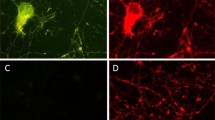Abstract
We have previously shown that sera from patients with Alzheimer’s disease (AD) contain antibodies to the cell bodies (perikarya; PK) of purely cholinergicTorpedo neurons, and that repeated immunization of rats with this neuronal preparation for over a year induces learning and memory impairments. In the present study, we examined the brain morphology of cholinergic PK immunized rats relative to controls. Immunohistochemical studies of the brains of these rats revealed the accumulation of IgG in specific areas, such as, the hippocampus. Parallel histochemical studies demonstrated significant changes in the hippocampus, and in white matter areas. They included large vacuoles and necrotic nuclei in the granular layer of the dentate gyrus, tangle-like appearance in some pyramidal neurons of the hippocampus, and vacuolar degeneration accompanied by oligodendroglia hypertrophy in white matter tracts, such as, the corpus callosum and fimbria. In contrast, immunization withTorpedo cholinergic nerve terminals, that has no cognitive effects on the rat, also did not induce brain morphological changes. These findings suggest that the learning and memory deficits induced by immunizing rats with cholinergic PK are related to the observed brain morphological changes, and support the hypothesis that the antibodies to cholinergic neurons found in the sera of AD patients may play a role in neuronal degeneration in this disease.
Similar content being viewed by others
References
Blessed G., Tomlinson B. E., and Roth M. (1968) The association between quantitative measures of dementia and of senile change in the cerebral grey matter of elderly subjects.Br. J. Psychiatry 114, 797–811.
Chapman J., Korczyn A. D., Hareuveni M., and Michaelson D. M. (1986) Antibodies to cholinergic cell bodies in Alzheimer’s disease,Alzheimer’s and Parkinson’s Diseases (Fisher A., Hanin I., and Lachman C., eds.), pp. 329–336, Plenum Publishing Corp., New York.
Chapman J., Bachar O., Korczyn A. D., Wertman E., and Michaelson D. M. (1988) Antibodies to cholinergic neurons in Alzheimer’s disease.J. Neurochem. 51, 479–485.
Chapman J., Feldon J., Alroy C., and Michaelson D. M. (1989) Immunization of rats with cholinergic neurons induces behavioral deficits.J. Neurol. Transplant. 1, 63–76.
Coyle J. T., Price D. L., and Delong M. R. (1983) Alzheimer’s disease: A disorder of cortical cholinergic innervation.Science 219, 1184–1190.
Dowdall M. J., Fox G., Wachtler K., Whitaker V. P., and Zimmermann H. (1976) Recent studies on the comparative biochemistry of the cholinergic neuron.Cold Spring Harbour Symposium on Quantitative Biology XL, 65–81.
Fabian R. H. and Petroff G. (1987) Intraneuronal IgG in the central nerous system: Uptake by retrograde axonal transport.Neurology 37, 1780–1784.
Fillet H., Luine V. N., Riesberg B., Amador R., Mcewen B., and Zabriske J. B. (1985) Studies of the specificity of antibrain antibodies in Alzheimer’s disease,Senile Dementia of the Alzheimer Type (Hutton J. T. and Kenny A. D., eds.) pp. 307–318, Alan R. Liss, New York.
Foley P., Bradford H. F., Dochert M., Fillet H., Luine V. N., McEwen B., Bucht G., Winblad B., and Hardy J. (1988) Evidence for the presence of antibodies to cholinergic neurons in the serum of patients with Alzheimer’s disease.J. Neurol. 235, 466–471.
Geinisman Y., van Toledo-Morrell L., and Morrell F. (1986) Aged rats need a preserved complement of perforated axospirous synapses per hippocampal neuron to maintain good spatial memory.Brain Res. 398, 266–275.
Hyman B. T., Van Hoesen G. W., Kromer I. J., and Damasio A. R. (1986) Perforant pathway changes and the memory impairment of Alzheimer’s disease.Ann. Neurol. 20, 472–481.
Ishii T. and Haga S (1976) Immuno-electron microscopic localization of immunoglobulins in amyloid fibrils of senile plaques.Acta Neuropath. (Berl.) 36, 243–249.
Kushner P. D. (1984) A library of monoclonal antibodies toTorpedo chollinergic synaptosomes.J. Neurochem. 43, 775–786.
McGeer P. L., Itagaki S., Tago H., and Mcgeer E. G. (1987) Reacive microglia in patients with senile dementia of the Alzheimer type are positive for the histocompatibility glycoprotein HLA-DR.Neurosci. Lett. 79, 195–200.
McRae-Degueurce A., Booj S., Haglid K., Rosengren L., Karrlsson J. E., Karlsson I., Wallin A., Svenerholm L., Gottfries C. G., and Dahlstrom A. (1987) Antibodies in cerebrospinal fluid of some Alzheimer disease patients recognize cholinergic neurons in the rat central nervous system.Proc. Natl. Acad. Sci. USA. 84, 9214–9218.
Meeker M. L., Meeker R. B., and Hayward J. N. (1987) Accumulation of circulating endogenous and exogenous immunoglobulins by hypothalamic magnocellular neurons.Brain Res. 423, 45–55.
Michaelson D. M. and Sokolovsky M. (1978) Induced acetylcholine release from active purely cholinergicTorpedo synaptosomes.J. Neurochem. 30, 217–230.
Nandy K. (1978) Brain-reactive antibodies in aging and senile dementia,Alzheimer’s disease: Senile Dementia and Related Disorders (Katzman R., Terry R. D., and Bick K. L., eds.) pp. 503–511, Raven Press, New York.
Nandy K. (1985) Immunopathology of aging and dementia,Senile Dementia of the Alzheimer Type (Hutton J. T. and Kenny A. D., eds.) pp. 293–305, Alan R. Liss, New York.
Patrick J. and Lindstrom J. (1973) Autoimmune response to acetylcholine receptors.Science 180, 871–879.
Richardson P. J., Walker J. H., Jones T., and Whittaker V. P. (1982) Identification of a cholinergic-specific antigen Chol-1 as a ganglioside.J. Neurochem. 38, 1605–1614.
Sims N. R., Bowen D. M., Allen S. J., Smith C. C. T., Neary D., Thomas D. J., and Davison A. N. (1983) Presynaptic cholinergic dysfunction in patients with dementia.J. Neurochem. 40, 503–509.
Singh V. K., Fudenberg H. H., and Brown F. R. (1987) Immunologic dysfunction: Simultaneous study of Alzheimer’s and older Down’s patients.Mech. Ageing. Dev. 37, 257–264.
Smith G. (1988) Animal models of Alzheimer’s disease: experimental cholinergic denervation.Brain Res. Rev. 13, 103–118.
Author information
Authors and Affiliations
Rights and permissions
About this article
Cite this article
Michaelson, d.M., Kadar, T., Weiss, Z. et al. Immunization with cholinergic cell bodies induces histopathological changes in rat brains. Molecular and Chemical Neuropathology 13, 71–80 (1990). https://doi.org/10.1007/BF03159909
Received:
Issue Date:
DOI: https://doi.org/10.1007/BF03159909



